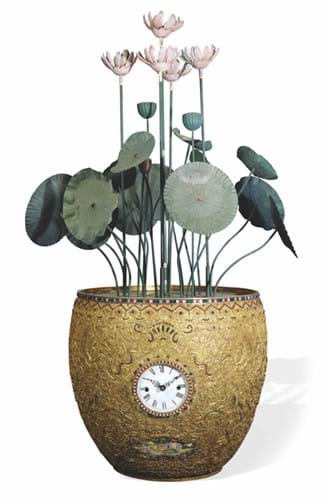
Dating from the Qing dynasty and standing an impressive 5ft 6in (1.69m) high, it takes the form of a lotus plant that rises up from the metal jardinière that also incorporates a clock and a musical movement and an enamel dial with roman numerals.
The automaton was offered for auction in a sale devoted largely to European furniture, paintings and works of art held by Gros & Delettrez on June 6. The €30,000-50,000 estimate was left far behind as the bidding rose to €1.22m (£1.09m) hammer.
Although Western clocks were introduced to the Ming Court by Jesuit missionaries, it was in the second half of the 17th century that imperial Chinese fascination with elaborate Western clocks and other mechanical works of art took off.
Skill-sharing
Demand from the east under the early Qing emperors provided a steady stream of employment for those missionaries skilled in the arts of western horology. They were able to instruct local Chinese craftsmen who combined their native skills in lacquerwork, cabinetmaking and hardstone cutting to satisfy imperial demand for this type of elaborate horology.
Special clockmaking workshops were created as part of the imperial workshops to restore and produce elaborate pieces for the court that were an amalgam of Oriental and Occidental skills, ingenuity and technical prowess.
The Gros & Delettrez automaton has a copper jardinière finely engraved with dragons and other motifs and decorated with coloured glass cabochons and Canton enamel panels featuring western figures and scenes.
The lotus plant rises up by means of a drawstring connected to a mechanism in the jardinière where the cylinder musical movement, which is operated by a push button in the top, and the clock movement are also housed.





